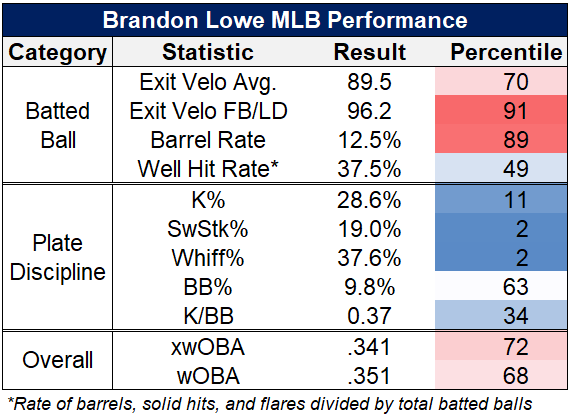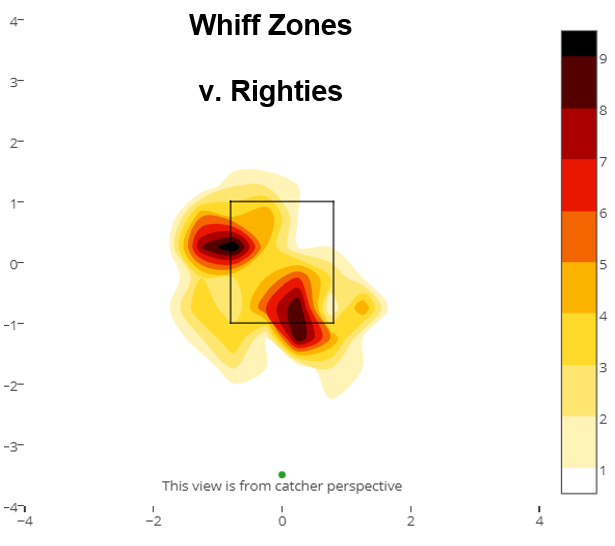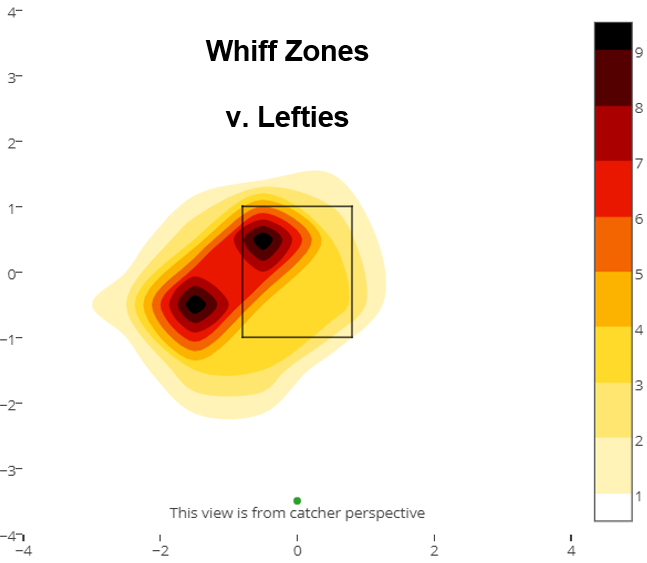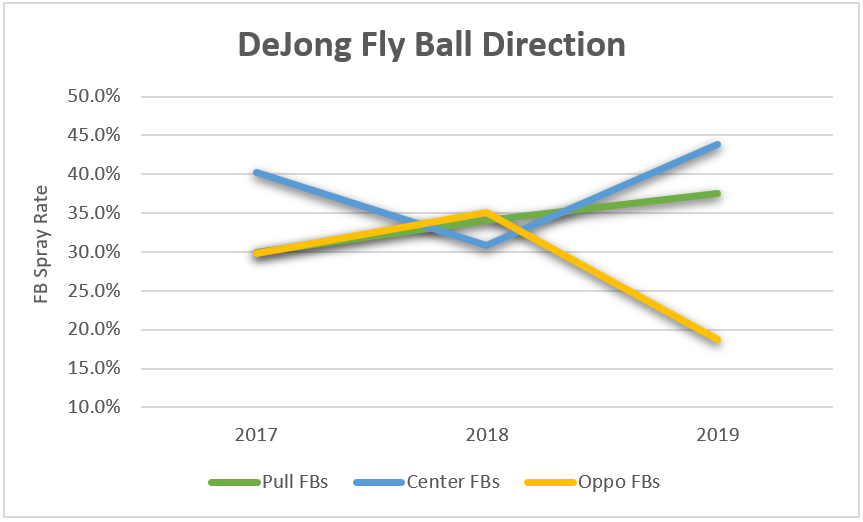Rather than devoting nearly 2,000 words to a single player or concept, as I tend to do with most of my Going Deep pieces, I’m going to change things up today and talk about two up-and-coming baseballers named Brandon Lowe and Paul DeJong. Both players are young middle infielders with a significant amount of pop in their bat; however, if you’re like me, you’ve been a bit unsure of their underlying strengths and weaknesses and how to value them going forward. Let’s fix that and dig in!
Lefty-swinging Brandon Lowe has had a strong a start to his professional career, to say the least. After being selected in the third round of the 2015 draft, Lowe made his professional debut in A-ball in 2016 and rapidly ascended the Tampa Bay Rays system, reaching the majors late last season. From there, he impressed Tampa brass enough in his 148 MLB plate appearances that they rewarded him with an eight-year, $49 million contract.
Lowe’s calling card in the minors was his patience at the plate, highlighted by a 12% walk rate, along with a plus hit tool that provided significant hard contact, evidenced by a .335 BABIP. But what propelled his ascension from AA to the majors last year was a power surge that resulted in an impressive 28 home runs across levels.
Lowe, clocking in at 5’10” and 185 pounds, doesn’t possess the standard build of a power hitter. However, he has spent years shaping his swing into an engine that produces output above the sum of its parts. According to Rays Manager Kevin Cash, “It seems like his hands are just timed up…He’s very whippy with his bat.”
https://gfycat.com/actualhighdamselfly
Lowe’s swing is all about load. He places most of the weight on his back foot, cocks his hands far back, torques his hips and obliques, then explodes into the ball. Although he doesn’t possess the same pronounced leg kick, the load mechanics of Lowe’s swing are reminiscent of Atlanta Braves third baseman Josh Donaldson, another player capable of generating outsized power despite a smaller frame.
Since his MLB debut on August 5, 2018, Lowe has utilized his torque-generating swing mechanics to swat 12 home runs in 224 plate appearances, a rate that would eclipse 30 over a full season, to go along with a .253 isolated slugging percentage and 125 wRC+. The power output is backed up by a 12.5% barrel rate that ranks near the 90th percentile of MLB hitters during that span.
Lowe also possesses an above average overall exit velocity and an elite exit velocity on flies and liners. However, his well-hit rate is merely average, indicating that his approach to date is very feast or famine, with a lot of dribblers and pop-ups to go along with some extremely well-hit balls.
This all-or-nothing approach also shows up in Lowe’s plate discipline metrics, with basement-level swinging strike rate and whiff rates. Striking out nearly 30% of the time is probably not sustainable for his overall batting line in the long-run.
Unfortunately, this is not a trend that has improved much, as Lowe’s 62.1% contact rate is the third-worst in baseball this season. Lowe also has difficulty making contact both inside and outside the zone.
Lowe’s contact struggles manifest against both righties and lefties, with respective 18.0% and 22.6% swinging strike rates against each in his career. Lowe’s biggest issue is an inability to catch up to fastballs up in the zone, particularly fastballs on the outer half the plate. He also struggles against sliders low and away from lefties, and curveballs down and in from righties.
The good news is that Lowe does make intelligent decisions about when to swing. His career zone swing rate of 78.8% shows that he attacks the ball when it’s over the plate. Meanwhile, his career chase rate is 30.3%. The 48.5% differential between the two is well above average and indicates Lowe is able to react well and make good choices about when to swing.
I suspect part of Lowe’s issue is that he’s so pull-inclined, with a 47.1% career pull rate, compared to the league average of 36.3%. Perhaps one of the reasons Lowe struggles so much with fastballs in the upper-outer part of the zone is that he’s attempting to pull them for home runs instead of lining them to the opposite field.
If he doesn’t iron out his swing-and-miss issues, I suspect Lowe’s strikeout rate will creep above 30% and result in long-term struggles at the plate. Fortunately, Lowe already possesses a good batter’s eye, so the solution likely comes down to bringing a more balanced, all-fields approach to the plate. This would also likely help him remedy the nearly 100 xwOBA differential between his success against righties (.360) and lefties (.262).
As it stands, I think Lowe’s 30-50% ownership rate between ESPN and Yahoo fantasy leagues is justified given his power output; however, I wouldn’t look to add or acquire him until he shows some meaningful improvement in his whiff tendencies.
Paul DeJong was snagged 54 picks after Lowe in the 2015 draft by the St. Louis Cardinals. Prior to his selection, DeJong played three years of Division 1 baseball at Illinois State University, where he majored in biochemistry with plans to attend medical school if his baseball career stagnated. Luckily, DeJong never had to pursue that backup plan, making his MLB debut with the Cardinals in May 2017, less than two years after being drafted.
DeJong’s calling card in his abbreviated minor league career was that of a power-hungry free-swinger. In a notoriously pitcher-friendly AA Texas League in 2016, DeJong managed to swat 22 home runs and 29 doubles along the way to a .200 isolated slugging percentage that ranked seventh in the league. However, he did so with a 26% strikeout rate that also ranked near the top of the circuit.
DeJong then broke out in a big way in 2017, demolishing the Pacific Coast League prior to his call-up with St. Louis. In a combined 633 plate appearances that year between AAA and the majors, DeJong blasted 38 home runs to go along with a .543 slugging percentage. Although DeJong struggled to carry that same success to his sophomore 2018 campaign, he is currently locked in as the Cardinals’ everyday shortstop and number-three hitter and off to a hot start in 2019.
DeJong stands fairly far back in the batter’s box and crowds the plate a bit with his stance, enabling him to feast on fastballs up and away, like the below home runs off Milwaukee Brewers hurler Freddy Peralta and former Braves pitcher Anibal Sanchez.
https://gfycat.com/TangibleMajorIndianelephant
https://gfycat.com/SoupyClumsyCottontail
The first home run was from earlier this season, while the second was from late 2018. While DeJong’s stance and leg kick look similar, he shows improved hand stability and quieter pre-swing mechanics in 2019. Those adjustments could be behind DeJong’s elite production thus far, placing in the top 10% of the league in xwOBA and wOBA and producing a 1.000+ OPS. Perhaps most inspiring, DeJong has cut his strikeout rate, which sat in the mid-to-high 20% range in preceding seasons, to 18.7% this year.
Interestingly, outside of an improvement in chase rate (O Swing %), DeJong’s contact and swinging strike rates are stable from 2018 to 2019. This indicates that the dramatic reduction in strikeout rate he’s experienced this season is unlikely to last. However, one could argue that DeJong didn’t deserve a 25% strikeout rate in 2018 based on his underlying plate discipline metrics, which all hovered around the league average. I suspect DeJong’s strikeout rate will settle at 21-22%, a range which will earn him an extra 20-25 opportunities to put the ball in play over a full season. Given DeJong’s career .225 isolated slugging percentage, those extra batted ball opportunities could convert to a sizable portion of extra-base hits.
Another adjustment that DeJong has made this season is a significant reduction in fly balls to the opposite field. This is a positive change, given that exit velocities on opposite field fly balls are significantly lower than those hit to the pull side and to center. And while some hitters adopt a sellout approach for pulled fly balls at the expense of increased whiffs and a predisposition to roll over on weakly hit groundballs, DeJong has done neither. In fact, DeJong has actually reduced his pull rate on groundballs, which is positive because it decreases the effectiveness of infield shifts against him.
The increase in pulled fly balls with a more balanced spray on grounders has resulted in career-high xStat readings for DeJong in 2019, with a 13.8% barrel rate and .476 expected batting average on contact. An increase in batted ball authority combined with a reduction in strikeouts is a rare feat for a young hitter to achieve and indicates that DeJong has raised his performance baseline above his 2017 and 2018 levels.
With roughly 80% ownership levels in both ESPN and Yahoo leagues, it’s unlikely DeJong is available on your free agent wire. However, existing owners should feel confident in holding him, while those in need of power from the middle-infield spot should consider trading for him if the value is right. A 30 home run, 90 RBI batting line paired with a .275 / .340 / .510 triple slash by season’s end is within reach.
Featured Image by Justin Paradis (@FreshMeatComm on Twitter)
(Lowe Photo by Cliff Welch/Icon Sportswire)
(DeJong Photo by John Adams/Icon Sportswire)






Agree with your analysis on Lowe so i remain skeptical there. But DeJong’s SwStr% is worse than last season. And 2.0-2.5*11.8% for his expected K% brings us to 25%, just like last year, not 21-22%. His approach for power is better but i expect he’ll begin striking out a lot, so i feel ambivalent (just like with Lowe), not super bullish.
Thanks for the comment, Dan.
Where did you get the 2.0 to 2.5 x SwStrk % for strikeout rate? The relationship definitely makes sense, but whether you use 2.0 or 2.5 has a fairly big effect on the outcome.
Also, DeJong’s overall contact rates have been slightly higher than you’d expect given his swinging strike rate, which is why I think he has some hidden upside in his strikeout rate.
I don’t think I will ever buy that a leg kick actually helps with power. Its a timing mechanism and it serves to get the weight on the back foot, but after that point (the swing) it is irrelevant. I think leg kicks get a lot of press because anyone can see it easily, but I don’t think they are actually important. A small step accomplishes the same goal. The good news for Lowe and hitters of his build is that it doesn’t take a whole lot to hit the ball out of the park in MLB. AAA used to be numbers that needed to be taken with a grain of salt v AA, now MLB looks like that compared to AAA. As we can see, the guys with good bat to ball skills get to sit next to players with real power in the juiced ball era if they want to. Juiced balls don’t benefit guys with huge power a whole lot as they didn’t hit many balls on the warning track to start. Its a weird wrinkle that makes it really hard to project power for young players.
I can’t imagine that the batted ball stats mean much of anything over a month. I’m sure that someone has declared that they stabilize after x PA, but I am harder to convince. Non x-stats like pull, hard, fb vary a lot from month to month and I would bet that xStats are worse as they are even more granular. You just can’t measure a person from a limited sample and there are too many variables to do it accurately. Any hot start or cold start would completely skew the numbers. By the time you get an adequate sample, the player or league should be making some changes. Its kind of weird to interpret every batted ball trend as a conscious change. We like to pat players on the back for their hot streaks, but I guess we should also interpret their struggles as bad decision making if you see it like that.
I think if you were lucky enough to pick up either of these two on the cheap, then you are pretty happy about it at this point. It’s hard not to see DeJong having a good season just based on lineup placement. I’ll take anyone hitting in the heart of a solid order. I think overall he is probably streaky as he has always been, but at least the run production will be there. Considering that neither were top 200, any consistent production is a bargain.